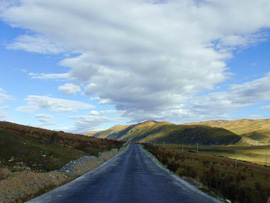Manikanko Town
 Once as an important trading center in ancient Tibetan times, Manigango remains a known transfer station on the Sichuan-Tibet highway. The town is located halfway between Ganzi and Dege. Leading to provinces like Yunnan, Qinghai and Sichua, the town was originally founded as a spot on the Tea-Horse Ancient Road. Unlike other towns in Tibet, Manigango remains well preserved and is known for its surrounding natural beauty. Its location makes it very accessible from many surrounding towns. Buses from Dege, Ganzi, as well as Shiqu, arrive daily and take between 3 and 5 hours drive time. When traveling from Dege, you will be driven through the Chola Mountain Pass. One of the highest in the area, over 5000 meters or 16,500 feet in altitude, this pass is covered in snow year-round.
Once as an important trading center in ancient Tibetan times, Manigango remains a known transfer station on the Sichuan-Tibet highway. The town is located halfway between Ganzi and Dege. Leading to provinces like Yunnan, Qinghai and Sichua, the town was originally founded as a spot on the Tea-Horse Ancient Road. Unlike other towns in Tibet, Manigango remains well preserved and is known for its surrounding natural beauty. Its location makes it very accessible from many surrounding towns. Buses from Dege, Ganzi, as well as Shiqu, arrive daily and take between 3 and 5 hours drive time. When traveling from Dege, you will be driven through the Chola Mountain Pass. One of the highest in the area, over 5000 meters or 16,500 feet in altitude, this pass is covered in snow year-round.
The Yilhun Lhatso (or the Xinluhai Lake) is only 10 kilometers outside of town and makes for a wonderful side trip. The lake is surrounded by rolling meadows and lush forests filled with evergreen Spruce, Fir and Cypress trees. Sitting picturesquely at the foot of the Que’er Mountains, the towering peaks perfectly backdrop the lake's landscape. On the backside of the lake, the glaciers from Mt. Chola can be seen. The entire area is a thankfully a nature preserve and will be around for generations to come. The scenery here really is the stuff fairytales are made of.
Besides the splendid scenery, famous Marnyi stones can be found lining the lake. These rocks were engraved with Buddhist sutras and are a delight to spot along the water. While various hotels and inns are located in Manigango, many visitors choose to camp along the lakeshores during warmer months. Hiking the rugged terrain is also a popular way to see the area. Or for the more adventurous tourist, horses and mules can be rented for the day. This fun and unique way to make your way around the lake is right in step with the town’s cowboy style. Entrance fee to the lake is 20 Yuan.
Another highlight of the town is the Zhuqing Monastery. Buddhist monks in bright crimson robes can be found wandering the town. The monastery here, often referred to as the Dzongchen Gompa, was founded in the late 17th century and is one of six main seats of the Nyingmapa sect. Various famous scholars, authors and monks hail from this monastery.
Manigango is known to be a true cowboy town. The largely nomadic population is similar to western notions of cowboys. The town’s people often ride horses, have dark, thick skin and even wear boots similar to traditional cowboy boots. Horse racing festivals are held here every summer. Plan your trip accordingly to experience a real taste of the Tibetan cowboy culture.